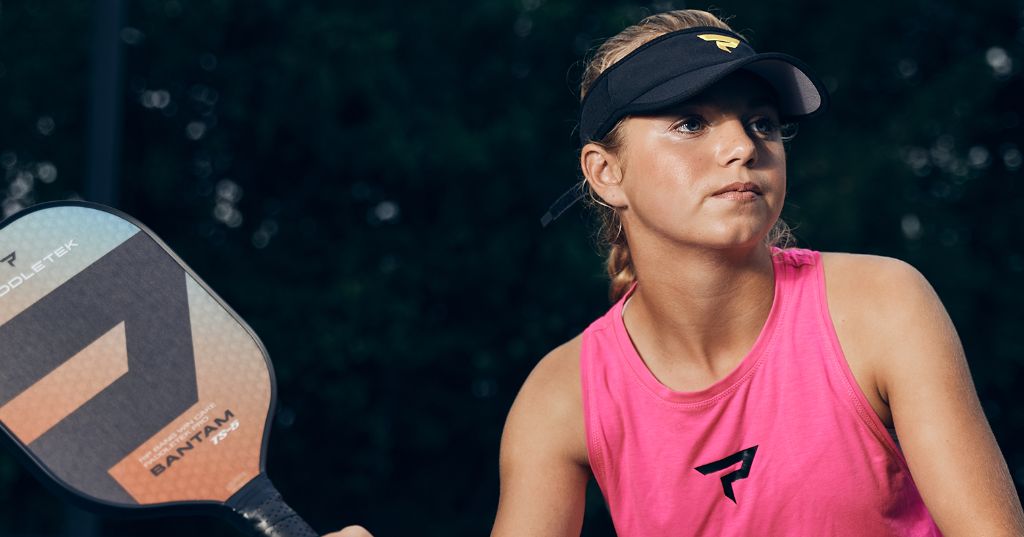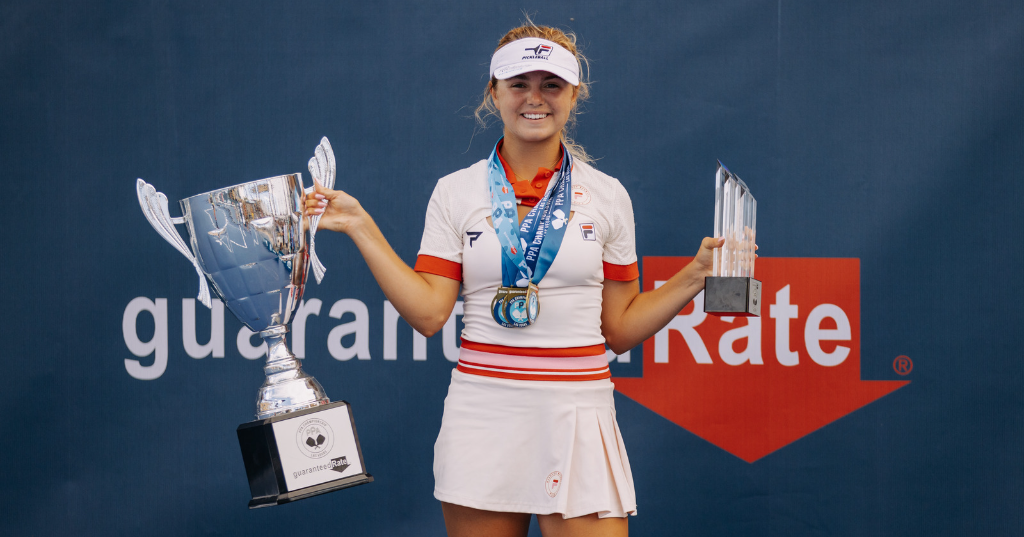Keeping the ball low ranks high for obvious tips, but there's more to it than meets the eye, and it's certainly easier said than done. While we're certain you could guess at least one reason to keep the ball low in pickleball, there are several you may have not considered but should know.
Here are 5 compelling reasons to keep the ball low in pickleball:
- More difficult to return with power and accuracy
- Your opponent will have less time to react
- Increases your control on each shot - placement, and spin
- Reduces the risk of a putaway from your opponent
- Forces your opponent to lift the ball
You probably could guess that hitting the ball low is going to make it more difficult for your opponents - and you've most likely heard someone say "aim for their feet" as a placement tip. But have you ever considered why? Let's go through each reason so you can fully commit to the importance of working on keeping the ball low in pickleball.
1. Low Balls Create More Difficult Returns
When you hit the ball low, it's far more difficult for your opponent to predict the trajectory of the ball. The difficulty of visual mapping where a ball is going to land exponentially increases as the ball gets further below eye level. This is just a fact of human nature.
Tracking the path of the ball and anticipating where it's going to touch down is more difficult as a result.
Another thing to consider is that low shots tend to skid and move quicker than shots with a higher arc, the most extreme example being a lob. This bounce just compounds the difficulty of returning a low shot.
And finally, when you hit the ball low, your opponent is more likely to have to make a big adjustment on their end to return the shot with any accuracy or power behind it. They'll have to dip down and make sure the paddle face is at an angle to clear the net, where most times they'll make contact below the net. All of this increases the odds of your opponents mishitting the ball and faulting as a result.
2. Decreased Reaction Time
Imagine you're on the court experimenting with the travel time of a pickleball. Your goal is to figure out how slowly and how quickly you can get the ball from your kitchen line to your opponent's kitchen line, and you get two shots total.
For your slowest shot, you need the ball to stay in the air as long as possible, so what do you do? You hit a high-arcing shot with some power behind it - the ultimate lob shot. And for the quickest shot, you smash it right at the kitchen line, making sure it just squeezes over the net - essentially creating the shortest distance between your paddle and the kitchen line.
You see where we're going with this - when you pop the ball up your opponent has all that time to figure out where it's going to be in reach for a hit, or even plan their next play. But if you hit it low, and with some pace, the best your opponent can do is attempt to get into a position to return it - relying solely on reflexes and prayers.
3. Improved Control and Placement
There are several reasons why hitting the ball low improves your control of the shot, and much of it relies on the same logic from the second point in this list. That is, a low shot will have a shorter flight path than a lob shot. While both shots could travel the same court distance, the path to get there could be significantly different.
A lob could have more than twice the distance in its flight path to reach the same destination as a direct line shot. This increased flight path reduces your control of placement and accuracy as it relies on three axes, rather than playing closer to 2 axes like a drive does.
We're getting heavy into geometry here, but math and physics are a big part of the game.
You'll also be able to have control by way of spin with a low shot, as it's more challenging to whip the ball with spin and keep it flying high. When you get over the top of the ball to keep it low, it makes it even easier to add some spin to your shot.
4. Reduces Odds of Easy Volleys
The strike zone is an interesting concept since it's one that many players know, yet rarely master. Technically, the strike zone is any range a player can reach with the paddle in their hand, but most often it's going to run from below the waist to even above their shoulders.
Most shots reachable above the waist are an invitation to attack. Balls that land around the shins or lower will be defensive shots, and in between the shins and waist can be either offensive or defensive opportunities. We promise we're going somewhere with this...
While most players know this concept, few players practice this full range. That is, shots slightly below the waist or at the shoulders are rarely worked on, which shrinks most players' strike zone.
This is good news for those who hit the ball low. Aiming for the feet will always be a challenge, but even if you're unable to get a clean shot that scrapes the court, your miss will still be well below the majority of players' strike zones.
Sometimes this will result in an error on their end, but most of the time it will prevent a great response to your shot, and assist in keeping them in a defensive strategy throughout the rally (more on that in a second).
So not only will low balls eliminate the risk of hitting high shots right into your opponent's strike zone, setting them up for putaway, but they'll also increase the likelihood of preventing them from entering an attack strategy.
5. Forces Your Opponent to Lift the Ball
This point dovetails into the prior point - where hitting the ball low prevents a volley return. But, it's a little different. Imagine you successfully hit the ball low, and the only moment your opponent can strike the ball is below their knees.
First, they'll have to dip to make contact with the ball, and second, they'll have to angle the paddle face up so that it clears the net. If the paddle face stayed level or more like a waist-high forehand, it would simply run into the net. This wouldn't be the worst case for you, but if your opponent clears the net, the only way to do so is to have an angle with the paddle face open.
The difference of a few degrees at contact is all it takes for them to pop it up - but the bigger point here is their motion is less like a strike, and more like a lift of the ball. This is subtle, but important, as it will matter less how good their technique of lifting is (as long as they don't completely miss the ball) - chances are that it won't reach your side of the court with a ton of power or spin. The best-case scenario is their lack of power and overreliance on the loft will allow you to end the rally.
But most often, their lift will keep them in the rally, but never threaten your position. And that's what it's all about - keeping them on defense so you can maintain control of the court.
Putting It All Together: Low Shots Put Opponents On Shaky Ground
By hitting the ball low in pickleball, you can make it more difficult for your opponent to return it with power and accuracy, they'll have less time to react, it increases your control over each shot - placement, and spin - and reduces the risk of a put away from your opponent, and most likely forces them to lift the ball over the net.
This means they are constantly playing from a defensive position, and creating attacking opportunities for you.
Playing defensively isn't a bad thing though, and not always a disadvantage -it can be a great tactic for court patience, controlling the pace of the game, and ultimately letting your opponent seal their fate.
What's different about hitting the ball low when it comes to defensive play, is it creates a playing style that is less of a choice and more so the only way to keep the ball in play.
It's panicky, constantly trying to reset or send a Hail Mary to keep the rally alive. It lacks any semblance of strategy, and that's no way to play pickleball. Or at least no way to win a game in pickleball.
Even though it creates attack opportunities, that doesn't mean every shot is the moment to close out the rally. Remember to always practice patience, even when you're on the attack. Sit in the pocket so to speak, and wait for that moment when the other side is out of position, struggling to reset, or you can tell they are anticipating your next shot, in which you'll take it to the extreme opposite to catch them off-guard.
Knowing the importance of this shot is half the battle. The other part of the equation is knowing how to keep the ball low in pickleball. If you're unsure of how to do this, be sure to check out our guide on how to hit the ball low in pickleball.




Leave a comment
This site is protected by hCaptcha and the hCaptcha Privacy Policy and Terms of Service apply.